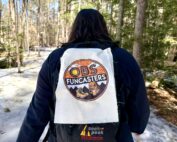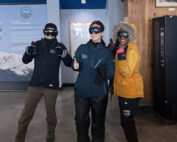Three Common Questions & Answers
2016-09-07 04:56:23.000 – Ryan Knapp, Weather Observer/Staff Meteorologist
Over the past week, we have been getting several emails, social media messages, and comments inquiring about three common things: operating hours, nights above treeline, and the Aurora Borealis. I always heard in college, “If you have a question, ask it out loud because odds are someone else in class is wondering the same thing and just not speaking up.” So, if we are getting these inquires over and over again, odds are, several other people are wondering the same thing but just not asking. So to help those individuals out, here are the answers to three common questions:
If coming to the summit, please remember that conditions can be drastically different than at the base. As my coworker mentioned yesterday, we typically see freezing temperatures and freezing/frozen precipitation later this month. So, be sure to check the Higher Summit Forecast page and our Current Conditions page to help prepare. And if hiking up, backcountry conditions can be found HERE. Please be mindful if hiking up that days are getting shorter (as of today, there’s nearly 2 hours less daylight than the first day of summer back in June). A headlamp should be in your pack and people should be mindful that operating hours will be adjusting to the shorter days and variable weather conditions.
Another option, if a member of the Observatory, is to volunteer for a week on the summit. More information about this membership perk can be found HERE.
Like many of you, we don’t know they are coming either; Mount Washington Observatory is a weather observatory and does not measure or monitor for Aurora Borealis or any space related activity. However, there are several websites that can assit in forecasts like spaceweather.gov, solarham.net, University or Alaska Fairbanks, or softservenews.com (which also has some social media apps that can alert you in Facebook or Twitter). Additionally there are several smartphone apps that can help notify if you search the Apple/Google stores for “aurora.” Be mindful that just because they are forecasted doesn’t mean you will see them as forecasts might be incorrect or the weather/moonlight might block their viewing.
If they are going to happen, head away from city lights, head to the south side of a pond/lake/large field or head to a knoll/hill/mountain with clear views north, once there look north, allow for at least 15 minutes for your eyes to adjust to the darkness (the longer the better and avoid looking at smartphones/smartwatches/tablets/light or you have to start over), dress warmly, and bring something to do as it could be a long wait. And don’t try looking for what you see in photographs, they rarely look like that – it will be closer to a blob of “alien gray/green” that looks like light pollution to most (it could in fact be light pollution if you’re unfamiliar with an area’s typical night sky view). However, if strong enough, the glow gets brighter and that is when you see pillars/curtains and movement; but not always.
Lastly, northern NH isn’t the only place to see them. I have photographer friends and people that I follow that have regularly shot them in Maine, southern NH, VT, and upstate NY with a few strong events shot in MA (as far south as the Cape) and northern RI. In really strong events, I have seen people photograph them in Arkansas, Texas, and Arizona. Personally I have seen and photographed them near Portland, ME, Chocorua Lake, NH, Head Pond, NH, and Killington, VT. So Mt Washington is far from your only option to see them if and when they are possibly viewable.
Ryan Knapp, Weather Observer/Staff Meteorologist
Team Flags Return for Seek the Peak’s 25th Anniversary
Team Flags Return for Seek the Peak's 25th Anniversary By MWOBS Staff Mount Washington Observatory is looking forward to continuing a much-loved tradition for Seek the Peak’s 25th Anniversary: Team flags. In inviting teams
Meet Summer Interns Zakiya, Max and Maddie
Meet Summer Interns Zakiya, Max and Maddie By MWOBS Staff We are excited to welcome six teammates to the summit of Mount Washington this summer! During their internship, these students and graduates will play
Saying Goodbye to the Summit
Saying Goodbye to the Summit By Alexis George After an extraordinary last three years working as a Weather Observer and Meteorologist, I am excited to pursue a different career. As sad I as am




